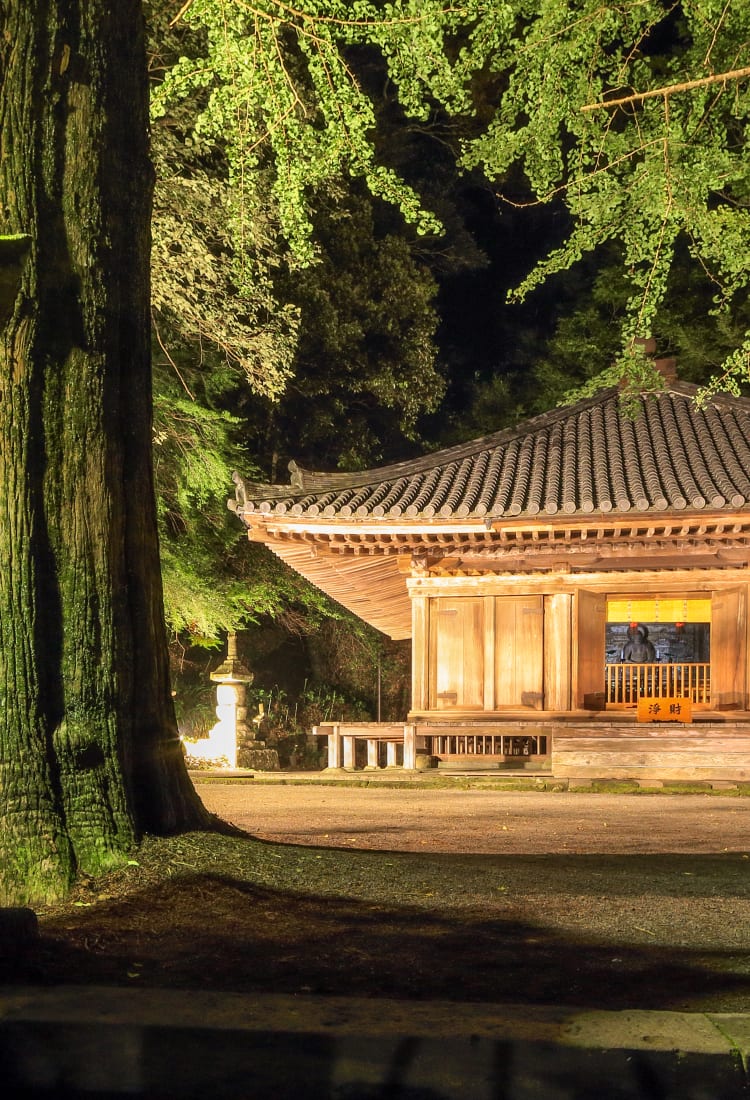

OITA Kunisaki Peninsula Venerable shrines and temples, and Buddha-filled caves
Venerable shrines and temples, and Buddha-filled caves
The Kunisaki Peninsula, set in the hinterlands of northern Oita Prefecture, has a remarkable array of time-honored temples and shrines as well as thousands of statues of the Buddha in caves.
For a change of scene, visit Showa no Machi, a recreation of a traditional town from the 1950s.
Don't Miss
- Usa-jingu Shrine, the head of more than 40,000 shrines devoted to the deity Hachiman
- Stepping back in time to retro Japan at Showa no Machi
- Fukiji Temple, designated a National Treasure
How to Get There
The main stations on the peninsula are Usa and Kitsuki, both accessible by bus and train, and covered by the Japan Rail Pass . If you wish to explore the peninsula's interior, you will need to rent a car.
Flights to Oita Airport from Haneda Airport in Tokyo take less than two hours and approximately one hour from Itami Airport in Osaka. From Oita Airport, take a limousine bus to Hiji Station and transfer to the Nippo Line to access Usa or Kitsuki Station.
From Oita Station, take the Sonic Limited Express or the Nippo Line to Kitsuki Station (35 minutes), or the Sonic-Nichirin Limited Express train to Usa Station (38 minutes).


Discover the caves of Mt. Rakan
The caves near Rakanji Temple are home to more than 3,700 stone figures of the Buddha, including 500 rakan, or disciples of Buddha. Stroll around the area for a serene and peaceful experience.
After checking out the panoramic views of the surrounding peaks and valleys from the top of Rakanji, visit the nearby Aonodomon Tunnel, built by a monk who wanted a safer route to the temple through Kyushu mountains. According to legend, it took him 30 years to dig the tunnel by hand.

Visit Usa-jingu Shrine, the premier Hachimangu shrine
Hachiman shrines are the second most numerous in Japan after Inari shrines. Hachiman shrines enshrine the legendary Emperor Ojin, deified as Hachiman-shin, the god of warriors.
Usa-jingu Shrine in the city of the same name was the first to enshrine this deity, making it the head of all Hachimangu shrines. The shrine has very close ties to the Imperial Family, especially since the Hachimangu shrine at Usa contributed very significantly in the building of the Great Buddha at Todaiji in Nara .
The expansive grounds cover about 150,000 square meters. Enter the shrine from the front to pass beautiful Hatsusawa Pond.
The contrast of Usa's white earthen walls, vermilion pillars, and accents of black and gold is striking. The museum to the right of the approach to the shrine is well worth a visit.
Visit Fukiji, one of Japan's three Amida Buddhist temples
Built in the 8th century, Fukiji Temple in the city of Bungotakada is the oldest wooden structure in Kyushu. The main hall is a National Treasure, and its seated wooden Buddha is one of Japan's Important Cultural Properties.
The peaceful forested surroundings and tranquil atmosphere make the temple an ideal place for relaxation and contemplation. Try an hour-long zazen seated meditation practice to tap into the temple's spiritual power.

A nostalgic 3D portrait of postwar Japan

Also in Bungotakada is Showa no Machi, a re-creation of a traditional Japanese town from the 1950s that is a popular spot for tourists and locals alike. Quaint shops with nostalgic signage sell electrical goods, snacks, toys and other items from the period.
Stroll the streets at your leisure or pick up a map of the neighborhood to uncover its hidden facets. There are a few museums worth visiting where toys and tools from the Showa era are on display.






























































